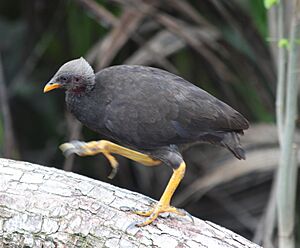Micronesian megapode facts for kids
Quick facts for kids Micronesian megapode |
|
|---|---|
 |
|
| Conservation status | |
| Scientific classification | |
| Genus: |
Megapodius
|
| Species: |
laperouse
|
| Subspecies | |
|
|

The Micronesian megapode is a special bird. It is also called the Micronesian scrubfowl. Its scientific name is Megapodius laperouse. This bird lives on islands in the Western Pacific Ocean. It is an endangered bird, which means it needs our help to survive.
Contents
What Does It Look Like?
The Micronesian megapode is a medium-sized bird. It is quite stocky, meaning it looks strong and solid. Most of its body is dark brownish-black. Its head is a bit lighter in color. It has a short, pale grey crest on its head. Its beak is yellow, and its legs and feet are large and a dull yellow color.
This bird is about 38 centimeters (15 inches) long. It has red skin on its face, which you can see through its thin feathers. It has very large feet and legs for its body size. Sometimes, people might confuse it with a dark-colored Red Junglefowl, which is a wild chicken.
The Micronesian scrubfowl got its name from a French explorer. His name was Jean-François de Galaup, comte de Lapérouse.
What Does It Sound Like?
The Micronesian megapode makes a loud "keek" sound. Often, two birds will sing together in a duet. One bird starts with a sound that gets higher and faster, like "keek-keek-keek-keek". This song ends with a loud "kee-keer-kew" (in Palau) or "keek-keer-keet" (in the Marianas). The other bird answers with a cackle that starts fast and then slows down.
Where Does It Live?
This bird can still be found in the Mariana Islands. In the past, it lived on islands like Asuncion, Agrihan, Pagan, Aguijan, and Alamagan. A few birds might still live on Saipan and Tinian. Sadly, it no longer lives on Rota and Guam.
Small groups of these birds like to live in thick bushes and scrublands on small islands. But on bigger islands, they can also be found in forests on higher ground. They prefer thick forests. These birds eat many different kinds of food they find on the forest floor. They are omnivorous, meaning they eat both plants and animals.
How Does It Behave?
Micronesian megapodes are often shy and like to stay hidden. But on islands where people protect them, they can become quite tame. They visit their nesting mounds several times a day. These birds like to move around in the shadows under small trees. They cannot fly for long distances. However, they are very good at running. This makes them very hard to catch!
The Micronesian scrubfowl and some other megapode birds are special. They are the only birds known to use heat from volcanoes to warm their eggs.
Reproduction and Life Cycle
During the breeding season, which is right after the southeast monsoon winds arrive, female megapodes build large mounds. They use things like leaves and dirt to make these mounds. They lay their eggs inside these mounds. Sometimes, several female birds will lay their eggs together in the same mound. However, females do not use the same mound more than once. Different females will use the mounds at different times.
After about one to two months, the eggs hatch. The baby birds, called chicks, will then eat grass shoots and insects.
How Are We Protecting It?
The Micronesian megapode is currently listed as "near threatened." This means it is close to being endangered. It lives in a very small area, mostly on quiet, untouched small islands. Megapodius laperouse lives in Palau and the Northern Mariana Islands. It has disappeared from Guam.
One big reason for the decline of these birds is introduced species. These are animals like dogs, cats, pigs, and rats that people brought to the islands. These animals hunt the megapodes and their eggs. Also, during the Japanese occupation of Saipan and Tinian, much of the natural forest was burned. It was replaced with large sugar cane farms. This destroyed the megapodes' homes.
Experts believe there are only about 2,000 to 2,500 of these birds left. You can find them in the island nation of Palau. They also live on quiet islands in the Northern Marianas chain. Several hundred live on Sarigan. A small group of these birds has recently been brought back to Saipan.
The Micronesian megapode is listed as "Endangered" by the IUCN Red List. This is because it lives in a very small area. It mostly lives on small, undisturbed islands. There are very few birds elsewhere. Because of all the threats it faces, its numbers are likely still going down.
To keep these birds safe, one idea is to protect a few small islands. Then, a small group of megapodes could be released there. This would create a safe population. On larger islands, more people and introduced animals will likely cause any megapode groups to disappear.
Subspecies
The Marianas Island megapode is a type of Micronesian megapode. Its scientific name is Megapodius laperouse laperouse. This is the main subspecies found in the Mariana Islands. It is rare and only found in certain places. It is in danger of disappearing.


